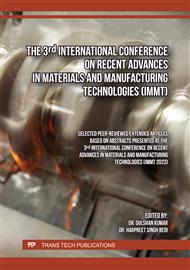p.3
p.11
p.19
p.31
p.41
p.57
p.67
p.79
A Mechanistic Cutting Force Model for Thin-Wall End Face Turning Operation
Abstract:
Many complex components may contain thin-walled flanges which are produced by end face turning operation. These thin-sections are likely to deform during end facing due to cutting forces resulting into form error in the final component. The current study mainly aims to understand the mechanistic cutting force components for thin-walled flange section with respect to its rigid counterparts. In order to realize the mechanistic cutting force components, advantages of both analytical and experimental approaches are exploited. First of all, process geometry variables such as uncut chip thickness, actual width of cut, instantaneous cutting speed are defined for end face turning. Based on the uncut chip thickness and actual width of cut, the effective cutting area is calculated which will be used as input for cutting force model. A separate set of machining experiments need to be conducted for finding out the values of cutting constants. Next, various cutting force components for end face turning are to be determined based on the effective cutting area and cutting constants. The variation in resultant force profile in thin-walled flange section is more with respect to rigid central core section. The force magnitude is gradually increasing in outer thin-walled flange section due to gradual reduction of workpiece deflection of the flange part whereas in central core section, force magnitude is almost constant in absence of workpiece deflection. The axial force component is more significant factor for part deformation and respective form error determination. The cutting force and feed force components are responsible for determination of power consumption. The axial force component is almost insignificant in this case.
Info:
Periodical:
Pages:
3-9
Citation:
Online since:
May 2025
Authors:
Price:
Сopyright:
© 2025 Trans Tech Publications Ltd. All Rights Reserved
Share:
Citation:



